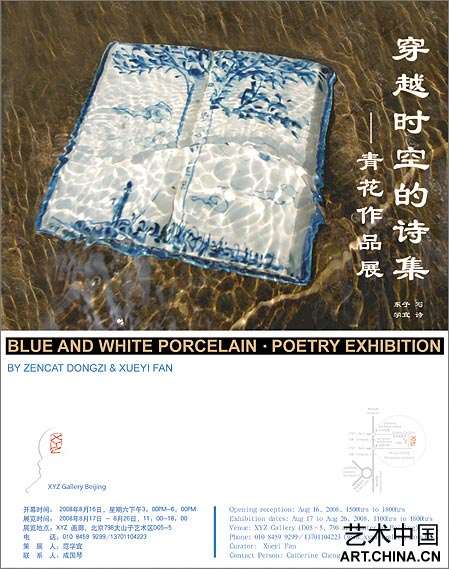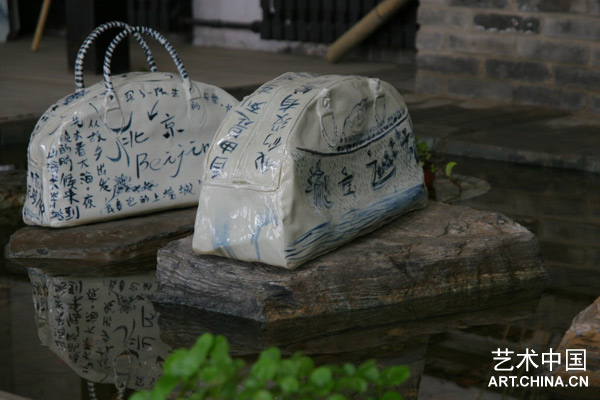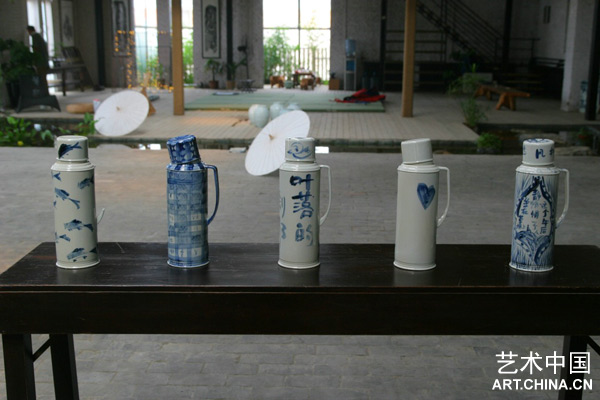
2008 BLUE AND WHITE PORCELAIN EXHIBITION BY ZENCAT AND XUEYI
Opening reception: Aug. 16, 2008, 1500hrs to 1800hrs
Exhibition dates: Aug. 17, to Aug. 30, 2008, 1100hrs to 1800hrs
Venue: XYZ Gallery, D05, 798 art center of Beijing
Phone: 010 8459 9299/13701104223
Curator: Xueyi Fan,Catherine Cheng
INTRODUCTORY ARTICLE
Poetry is the experiences and emotions of life, processed through an artistic soul. Without living, without suffering, without joy, there would be no poetry. Wallace Stevens claimed that he wrote poetry to help people live their lives, and the poet Xueyi writes for the same reason. Her words are both inspirational and motivational. To understand the poet is to understand her poetry, and to understand her poetry helps one to better understand their own life experience.
The poems of Xueyi are illuminated through the artistic hand of Zencat. A renowned ceramic artist, Zencat read the poems of Xueyi and heard the story of her life, and was inspired to create ceramic works that served as tangible images of Xueyi’s writings and experiences. Zencat’s career as a ceramic artist began in 1988, when she began working with the medium. In 1994, she was the first artist in China to receive an independent scholarship awarded by the French National art Foundation to work in France with a local artist. She has exhibited in France and Italy, and won an award at a show in Florence, Italy. However, Zencat did not devote herself consistently to ceramics because she felt that she was still a ‘student’ of life and was therefore not ready to devote herself fully to the medium. When she met and heard Xueyi’s story, she felt she had ‘graduated’ and was ready to devote herself completely to working in ceramics. Zencat, who is also an author, believes that art must not be merely commercial, but must be used for a higher purpose – to speak truth, and to tell stories that need to be told. Xueyi’s story inspires her as something worthy of the devotion of art because it speaks of sorrow giving way to hope.
It is both Xueyi’s story, and the story of China. Indeed, it is the story of humanity. The exhibit is dedicated to Mothers, and to Mother China.
The poems Zencat illustrates with her ceramic works were written in Xueyi’s youth. Born in a remote area of Northeast China to a life of privation, the young Xueyi lived with her family, and found happiness largely in the nature around her and within her fertile imagination. At the age of 7, Xueyi began to create poetry. Her poems then were sung she did not attend school until the age of 11. In Xueyi’s young life, one finds the symbols and themes in Zencat’s current blue and white porcelain works based upon Xueyi’s poetry: a tent, leaves, birds, stars, flowers, a mirror, books, slippers, a spatula, pillow, thermos and red fruit balls (tanghulu).
Flowers and leaves are important images from Xueyi’s young life. Xueyi’s mother suffered from the sporadic appearance of inner demons, and at these times, would withdraw from the world. Xueyi’s mother would disappear into the forest to live in a tent for extended periods of time, wrestling in solitude with her despair. Xueyi would then abandon school to look for her mother, searching in the forest surrounded by wild flowers and grass for the tent where her mother hid, waiting for her young daughter to lead her back home. Due to her mother’s disappearances, Xueyi’s school experience was inconsistent. She did, however, love book as a child. Some of her fondest memories stem from the making of books of poetry in her childhood, where her own first poetry book entitled Childhood River published in 2000, and Zencat thus portrays books in her porcelain works to portray their importance in Xueyi’s young life.
But Xueyi’s life was also one of privation, represented by the newspapers and mirrors in Zencat’s works. As a child, Xueyi had no mirror in which to see herself, and she had no newspapers to read. These two things – newspapers and mirrors – symbolize the longing and desire for knowledge of both herself and the world around her that Xueyi felt as a child. Her desire to know more, to see more of the world, burned within her young heart until she was moved to do something about it.
To illustrate Xueyi’s desire to see and experience more of the world, Zencat uses the image of slippers in her work. The story behind this is both charming and poignant. In 1997, Xueyi went to Beijing and stayed in the student dormitory of a school. She picked up a pair of slippers that her classmate abandoned, as she had no money to buy shoes. Therefore, she could go to see the fountain in front of a hotel. However, she was rejected by the hotel when she was invited by a friend to have dinner in the hotel, because the hotel stating that one could not come in without proper dress.
The spatula is another powerful image from Xueyi’s life. Because of her mother’s incapacitation, Xueyi had to begin cooking for the family at the age of 8. Bird and stars are symbols of creativity, joy and hope. The image of a bird on a star represents the motivation in your heart to seek joy and to create beauty in life.
Another interesting image in Zencat’s works is the travel bag with a zipper. These bags were commonly used by people of Xueyi’s parents’ generation when they left their hometown. Inside they would place all of the family possessions – not gold and silver, but glasses, toothbrushes, a sweater, umbrella, some eggs and a cup. In the porcelain travel bag, Zencat has placed a story about Xueyi’s train trip to Beijing. Leaving the mountainous region of her family, Xueyi travelled for a long time beyond the mountains, past the place where the Great Wall stretches in to the sea, to reach the outskirts of Beijing. When she arrived, she saw flowers blooming and thought ‘I will stop here’. On the sides of the bags are the names of the places she stopped – up to and including 798. It is interesting to note that one of the travel bags has a broken handle. It represents those parts of our home, of our past, that we can’t take with us when we leave, but that we can’t really leave behind or forget. The travel bags also represent New China – everyone is on a journey, and they can’t take the China of the past with them, though they can hold it in their memories.
In each of Zencat’s and Xueyi’s collaborative works, one is touched by the intersection of the poet’s past with the artist’s present and our own emotional experience. Indeed, these artists remind us what art is really here to do – to help us go beyond materialism and re-connect with our spirituality, thereby helping us to better live our lives. More than simple amusement, art is essential to life. To remind us of this, Zencat uses the ancient symbol meaning ‘For the Emperor’ in her work, a symbol which denotes sophistication and high quality and stands for freedom, tolerance, integrity, hope, bravery, and wisdom. But these works are for us – for the emperor in our hearts. We need it to remind us that life in this modern world should be more than mere accumulation – it should be an exercise in discovering the profound, the poignant, and the beautiful.
By Caryn Voscuil, PHD
Edited by Catherine Cheng

青花旅行袋Travel Bag_Zencat Porcelain_Xueyi Poetry

青花暖瓶Thermos_Zencat Porcelain
|

